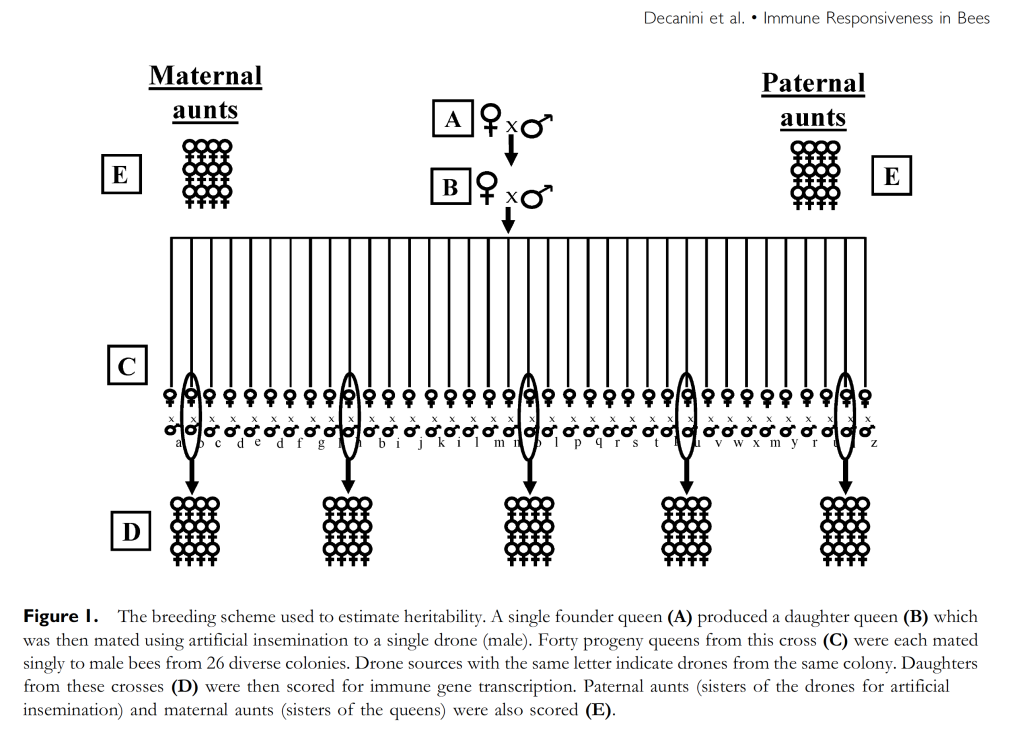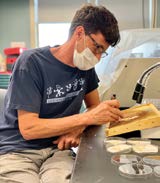Click Here if you listened. We’re trying to gauge interest so only one question is required; however, there is a spot for feedback!
Read along below!
Found in Translation
Missing Their Better Half, More on Drone Genetics
By: Jay Evans, USDA Beltsville Bee Lab
Last month I wrote a tragic, and maybe a little droning, article about the shortcomings of male honey bees and their fragility. On a more uplifting note, drone genetics have great potential for use in honey bee breeding. Male bees, like male ants and male wasps, have half a deck of chromosomes, 16/32nds to use a precise carpenter term. These 16 chromosomes provide all of the information needed to make a bee (obviously) but with no redundancy for the most part. When there is a critical mutation in a critical gene, that bee will not fly. This liability is actually a gift in disguise for breeding and genetics in several ways.
Remember that, despite their limited job duties, not all male bees are equal. Differences among drones impact their ability to contribute genes during mating, and the value of those genes to their unseen offspring should drones win the mating lottery. Bradley Metz and David Tarpy showed that male bees in commercial beekeeping operations differed by two-fold in weight and by an amazing 100-fold in the amount of sperm they have available for mating (Metz, B. N., and D. R. Tarpy. 2021. Reproductive and morphological quality of commercial honey bee (Hymenoptera: Apidae) drones in the United States. Journal of Insect Science 21, https://doi.org/10.1093/jisesa/ieab048). By their estimate, 6.5% of adult drones in commercial operations were of ‘low quality’. To produce males matching the subpar guys, these scientists had to raise males in smaller worker cells. As expected, 83% of males raised in worker cells were graded as ‘low quality’, versus 2% of males raised at the same time in proper drone cells. Since males are unlikely to be raised in worker cells in the field, other colony or genetic factors must lead to the production of low-quality males. The usual suspects are disease, chemical stress and poor nutrition, although this study did not explore those causes. Interestingly, bee genetics can also play a role in variable drone traits, and in drone reproductive traits in particular. Garett Slater and colleagues reviewed substantial data showing that races of bees differed consistently in drone traits such as sperm count and sperm longevity (Slater, G.P.; Smith, N.M.A.; Harpur, B.A. 2021. Prospects in connecting genetic variation to variation in fertility in male bees. Genes, 12, 1251. https://doi.org/10.3390/genes12081251). While mated queens use only a fraction of the sperm received over the multiple mating events they engage in, there is some evidence that queen egg-laying is negatively impacted by mating with poor-quality males. Overall, these studies indicate the value of exposing your queens to healthy males.
 Given all these weaknesses, what do males bring to the queen selection table? Being haploid means that individual males can have a disproportionate effect on offspring traits. In a hypothetical mating between a queen and a single male, the worker bee offspring are “super-sisters” in that they are identical on their dad’s side. In contrast, sisters share roughly half of their mom’s genotype (a term for the combined variants seen in a typical diploid animal). Male-driven breeding, coupled with instrumental insemination (since no one has time to direct males on the wing to precise matings), has huge potential to shift bee populations toward desirable traits. In our group, Laura Decanini led such an attempt for earlier efforts to identify resistance to American foulbrood (Decanini, L. I., A. M. Collins, and J. D. Evans. 2007. Variation and heritability in immune gene expression by diseased honey bees. Journal of Heredity 98:195-201, doi:10.1093/jhered/esm008) Starting with genetically homogeneous breeder queens, from a singly-mated Italian mom, we were able to produce a 100-fold range of immune traits when crossing those queens to a diverse set of 26 local drones. Heritability for both immune activity and survivorship in the face of P. larvae was high, as measured by comparing immune traits of resulting offspring with their ‘aunts’ from the 26 drone source colonies.
Given all these weaknesses, what do males bring to the queen selection table? Being haploid means that individual males can have a disproportionate effect on offspring traits. In a hypothetical mating between a queen and a single male, the worker bee offspring are “super-sisters” in that they are identical on their dad’s side. In contrast, sisters share roughly half of their mom’s genotype (a term for the combined variants seen in a typical diploid animal). Male-driven breeding, coupled with instrumental insemination (since no one has time to direct males on the wing to precise matings), has huge potential to shift bee populations toward desirable traits. In our group, Laura Decanini led such an attempt for earlier efforts to identify resistance to American foulbrood (Decanini, L. I., A. M. Collins, and J. D. Evans. 2007. Variation and heritability in immune gene expression by diseased honey bees. Journal of Heredity 98:195-201, doi:10.1093/jhered/esm008) Starting with genetically homogeneous breeder queens, from a singly-mated Italian mom, we were able to produce a 100-fold range of immune traits when crossing those queens to a diverse set of 26 local drones. Heritability for both immune activity and survivorship in the face of P. larvae was high, as measured by comparing immune traits of resulting offspring with their ‘aunts’ from the 26 drone source colonies.
Even more powerful are attempts to screen drones themselves for desired traits, then collect and use sperm only from the drones who aced their fitness test. Ivelina Ivanova and Kaspar Bienefeld in Germany attempted to use drones as a surrogate for worker hygienic behavior, by subjecting drones to the ‘Proboscis Extension Reflex’ a common assay for learning and behavior in workers. (Ivanova, I. and Bienefeld, K. 2021. Suitability of drone olfactory sensitivity as a selection trait for Varroa-resistance in honey bees. Scientific Reports 11, https://www.nature.com/articles/s41598-021-97191-w). In worker bees, the PER can be used to assess responsiveness to the chemicals that trigger hygienic behaviors. Bees, which are smarter than most insects, will stick their tongues out for a food reward and can be trained to do so for cues like smells, learning like Pavlov’s dog to associate those smells with something good. Males in this study figured out the PER, as do worker bees, although males apparently do so with less vigor and more ‘nervousness’. Also, in the current study, “We observed a greater unwillingness of drones to respond to the CS+ and the sugar solution on cold or rainy days, although the temperature in the laboratory was regulated”, and “during our preliminary tests, we also observed high drone mortality if drones were treated according to existing bee protocols”. To go easy on these fragile males, the PER study was shortened, and the authors were able to generate usable data. Sadly, males that scored well in these standardized tests did not father the most hygienic offspring, so there was a disconnect there somehow. Still, males from high-scoring colonies helped perpetuate that trait, a validation of PER and comb-based hygienic tests for improving this key trait… but only when female bees are asked to take the test for their brothers. This does not rule out using male bees as a direct screen for individual resistance traits, including immunity. Drone-level screens of immunity followed by instrumental insemination give a direct path to stock improvement since drones fend off disease with the same immune response as their sisters. Scientists, including my USDA colleague Michael Simone-Finstrom and bee breeder Daniel Weaver, are using drone screens of disease response to enhance stock resistance (https://www.ars.usda.gov/research/project/?accnNo=441927). Drones still have time to show their strengths and it is fascinating to contemplate how being ‘haploid’ affects male contributions to colony life. Something to buzz about as we edge past the long drone of February toward Spring and colony renewal.









